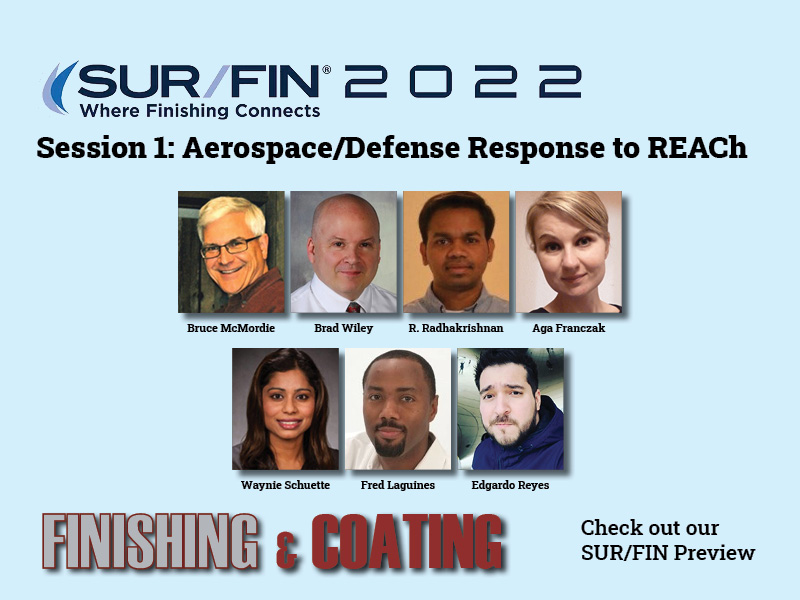Session 1 at the NASF SUR/FIN Technical Conference will be on “Aerospace/Defense Response to REACh.”
Here are the abstracts for the presentations. Please visit www.nasfsurfin.com for information on registering for the event:
Tuesday, June 7
Session 1: Aerospace/Defense Response to REACh
Session Chairs Brad Wiley, Rolls Royce, and Mike Ware, Boeing Co.
8:30 – 9:00: Development of a Novel Hexavalent Chromium-Free Aluminum Sacrificial Paint — Bruce McMordie, Coatings for Industry
 Bruce McMordieThe research and development of any coating system is time consuming and fraught with failure. When success is achieved in an area as challenging as the aerospace industry demands, it is valuable to summarize and reflect on the process. Hexavalent Chromium is a known carcinogen, repro-toxin, and mutagen. Its elimination is of high importance to the aerospace industry which has struggled to find high performing alternates. Legacy aluminum sacrificial paints have traditionally utilized hexavalent chromium to prevent corrosion and oxidation of steels. Due to the high performance nature of these coatings, work to approve alternate coatings have been difficult. Many attempts have resulted in failure. The process of developing a novel hexavalent-chromium-free aluminum sacrificial paint will be summarized. The history, failures, and key factors will be summarized. This presentation is intended to be tandem with the Rolls-Royce presentation on the testing results of this novel coating system.
Bruce McMordieThe research and development of any coating system is time consuming and fraught with failure. When success is achieved in an area as challenging as the aerospace industry demands, it is valuable to summarize and reflect on the process. Hexavalent Chromium is a known carcinogen, repro-toxin, and mutagen. Its elimination is of high importance to the aerospace industry which has struggled to find high performing alternates. Legacy aluminum sacrificial paints have traditionally utilized hexavalent chromium to prevent corrosion and oxidation of steels. Due to the high performance nature of these coatings, work to approve alternate coatings have been difficult. Many attempts have resulted in failure. The process of developing a novel hexavalent-chromium-free aluminum sacrificial paint will be summarized. The history, failures, and key factors will be summarized. This presentation is intended to be tandem with the Rolls-Royce presentation on the testing results of this novel coating system.
9:00 – 9:30: Hex-Chrome-Free Aluminum Sacrificial Paint Qualification Results (Success!) — Brad Wiley, Rolls Royce
 Brad WileyHexavalent Chromium is a known carcinogen, repro-toxin, and mutagen. Its elimination is of high importance to the aerospace industry which has struggled to find high performing alternates. Legacy aluminum sacrificial paints have traditionally utilized hexavalent chromium to prevent corrosion and oxidation of steels. Due to the high performance nature of these coatings, work to approve alternate coatings which are equal to or better than have been difficult. Many attempts have resulted in failure. A body of results will be shared substantiating efficacy of a leading replacement. Performance testing includes cyclic-synthetic-sea-water (salt spray/humidity/ambient) corrosion testing, continuous neutral salt spray corrosion testing, cyclic salt spray/humidity corrosion testing, cyclic salt spray/heat/humidity corrosion testing, heat resistance testing, fluid resistances testing, adhesion testing, conductivity/resistivity, metallography, quality, stripping, and touch up.
Brad WileyHexavalent Chromium is a known carcinogen, repro-toxin, and mutagen. Its elimination is of high importance to the aerospace industry which has struggled to find high performing alternates. Legacy aluminum sacrificial paints have traditionally utilized hexavalent chromium to prevent corrosion and oxidation of steels. Due to the high performance nature of these coatings, work to approve alternate coatings which are equal to or better than have been difficult. Many attempts have resulted in failure. A body of results will be shared substantiating efficacy of a leading replacement. Performance testing includes cyclic-synthetic-sea-water (salt spray/humidity/ambient) corrosion testing, continuous neutral salt spray corrosion testing, cyclic salt spray/humidity corrosion testing, cyclic salt spray/heat/humidity corrosion testing, heat resistance testing, fluid resistances testing, adhesion testing, conductivity/resistivity, metallography, quality, stripping, and touch up.
9:30 – 10:00: Direct Electrodeposition of Ni/Ni Alloys Onto Aluminum After One Step Surface Pretreatment — Dr. Rajeswaran Radhakrishnan, Faraday Technology
 Dr. RadhakrishnanFaraday will describe recent research work on the development of corrosion resistant coatings directly applied to aluminum alloys (6061/4047) after a one-step electrochemical surface pretreatment process. Applying coatings to aluminum commonly requires extensive and specialized surface pretreatment processes (such as zincate and electrolysis NiP application) prior to deposition, owing to aluminum’s reactive nature and affinity for oxygen. In this study we will discuss a simple pretreatment process that enables direct deposition of ZnNi, NiP, or Ni coatings onto Al alloys and can dramatically reduce the cost and challenges associated with the surface preparation of Al. Furthermore, we will discuss the corrosion/erosion performance of the Ni, and NiP coatings applied directly to 6061 Al and
Dr. RadhakrishnanFaraday will describe recent research work on the development of corrosion resistant coatings directly applied to aluminum alloys (6061/4047) after a one-step electrochemical surface pretreatment process. Applying coatings to aluminum commonly requires extensive and specialized surface pretreatment processes (such as zincate and electrolysis NiP application) prior to deposition, owing to aluminum’s reactive nature and affinity for oxygen. In this study we will discuss a simple pretreatment process that enables direct deposition of ZnNi, NiP, or Ni coatings onto Al alloys and can dramatically reduce the cost and challenges associated with the surface preparation of Al. Furthermore, we will discuss the corrosion/erosion performance of the Ni, and NiP coatings applied directly to 6061 Al and
10:00 – 10:30: Evaluation of Purpose Built Tooling Concept for Electroplating of Hard Chrome on Aerospace Components — Dr. Aga Franczak, Elsyca NV
 Dr. Aga FranczakIndustrial hard chrome plating is a rather complex, lengthy and labour-intensive process: typically, the low cathodic current efficiency of Cr plating baths results in limited deposition rates, taking an hour to deposit a thickness of 25 mm on any size of the part. In the majority of cases, the hard Cr plating process requires the use of tooling structures, making the process strongly operator-dependent and therefore, highly prone to errors. According to the Fokker Landing Gear BV team, operator- independence as well as process simplification are expected to be achieved by developing a purpose- built tooling concept. An intelligent support of employees in their increasingly complex work is also sought and thus far addressed by implementation of modern smart technologies. One of them is computer modeling and simulation, which enables to mirror the physical world in a virtual model. This smart manufacturing approach allows operators to test and optimize the process settings in the virtual world before introducing any actual physical changes and therefore, driving down operator dependence and simplifying process management. The work presented here will demonstrate how computer modeling is used in a typical aerospace electroplating environment, accounting for a process design, analysis and optimization. The use of simulation approach based on the Fokker Landing Gear example will be discussed in detail
Dr. Aga FranczakIndustrial hard chrome plating is a rather complex, lengthy and labour-intensive process: typically, the low cathodic current efficiency of Cr plating baths results in limited deposition rates, taking an hour to deposit a thickness of 25 mm on any size of the part. In the majority of cases, the hard Cr plating process requires the use of tooling structures, making the process strongly operator-dependent and therefore, highly prone to errors. According to the Fokker Landing Gear BV team, operator- independence as well as process simplification are expected to be achieved by developing a purpose- built tooling concept. An intelligent support of employees in their increasingly complex work is also sought and thus far addressed by implementation of modern smart technologies. One of them is computer modeling and simulation, which enables to mirror the physical world in a virtual model. This smart manufacturing approach allows operators to test and optimize the process settings in the virtual world before introducing any actual physical changes and therefore, driving down operator dependence and simplifying process management. The work presented here will demonstrate how computer modeling is used in a typical aerospace electroplating environment, accounting for a process design, analysis and optimization. The use of simulation approach based on the Fokker Landing Gear example will be discussed in detail
10:30 – 11:00: Corrosion Resistant Boegel as a Non-Hexavalent Chromium Pretreatment — Waynie Schuette, Vivek Kapila, Boeing Corp.
 Waynie Schuette and Vivek KapilaCorrosion protection of aerospace alloys has traditionally relied on the use of hexavalent chromium conversion coatings (CCC). However hexavalent chromium is a carcinogen and is toxic to the environment. Elimination of hexavalent chromium from conversion coatings, primers and processes will enable worker safety, enable cost avoidance by eliminating use of hazardous chemicals, baths and wastes and allow Boeing to be REACH, OSHA and EPA regulation compliant. Boegel is an organo-silane based adhesion promoter qualified to BMS10-128 and primarily used on clad aluminum skins of the 737, 747, 767 and 777 aircrafts. The use of Boegel on these platforms eliminated the use of chromate conversion coatings on the exterior surface of the aircrafts and helped solve the rivet rash problems caused by poor paint adhesion to aluminum rivets. Boegel EPII (commercially available as AC131 from 3M) was originally designed to enhance bond adhesion to aluminum surfaces and adhesion to subsequent epoxy primers, however provided no sacrificial standalone corrosion resistance to the base substrate. This study details investigating the addition of corrosion inhibitors to Boegel (corrosion resistant Boegel or CRB) to provide an extra layer of corrosion protection adjacent to the metal surface without compromising paint adhesion. Corrosion resistance of CRB was evaluated with best performing non-chromate primers from PPG, Akzo Nobel, Hentzen and Av-Dec and a PPG polyurethane topcoat. The corrosion performance of CRB was also compared to standard sol-gel (AC-131 from 3M), Alodine 1200, Alodine 5200 and SurTec 650V pre- treatments
Waynie Schuette and Vivek KapilaCorrosion protection of aerospace alloys has traditionally relied on the use of hexavalent chromium conversion coatings (CCC). However hexavalent chromium is a carcinogen and is toxic to the environment. Elimination of hexavalent chromium from conversion coatings, primers and processes will enable worker safety, enable cost avoidance by eliminating use of hazardous chemicals, baths and wastes and allow Boeing to be REACH, OSHA and EPA regulation compliant. Boegel is an organo-silane based adhesion promoter qualified to BMS10-128 and primarily used on clad aluminum skins of the 737, 747, 767 and 777 aircrafts. The use of Boegel on these platforms eliminated the use of chromate conversion coatings on the exterior surface of the aircrafts and helped solve the rivet rash problems caused by poor paint adhesion to aluminum rivets. Boegel EPII (commercially available as AC131 from 3M) was originally designed to enhance bond adhesion to aluminum surfaces and adhesion to subsequent epoxy primers, however provided no sacrificial standalone corrosion resistance to the base substrate. This study details investigating the addition of corrosion inhibitors to Boegel (corrosion resistant Boegel or CRB) to provide an extra layer of corrosion protection adjacent to the metal surface without compromising paint adhesion. Corrosion resistance of CRB was evaluated with best performing non-chromate primers from PPG, Akzo Nobel, Hentzen and Av-Dec and a PPG polyurethane topcoat. The corrosion performance of CRB was also compared to standard sol-gel (AC-131 from 3M), Alodine 1200, Alodine 5200 and SurTec 650V pre- treatments
11:00 – 11:30: Cr-Free Superhydrophobic Topcoat and Primers — Fred Laguines, Engineering and Software System Solutions (ES3)
 Fred LaguinesHexavalent chromium is commonly utilized in coatings across the U.S. Department of Defense (DoD), especially in epoxy primers. ES3 has developed a superhydrophobic primer and topcoat that does not contain hexavalent chromium and results in contact angles of greater than 150 degrees. This effort seeks to eliminate chromium from the topcoat and primer, while increasing hydrophobicity, icephobicity, cleanability, and maintainability, resulting in an improved coating stack up that’s better for the maintainer, the aircraft, and the environment. This objective of this effort addresses the need to eliminate the use of hexavalent chrome-based primers commonly found in primers by developing a Cr-free epoxy primer and polyurethane topcoat with superhydrophobic (SH) pigments for aerospace applications and use. The coating has been extensively tested against legacy military primer and topcoat specifications, MIL-PRF-23377 and MIL- PRF-85285, respectively. ES3 is working with a chemical manufacturer to advance development of the superhydrophobic primer and topcoat that has passed military specification testing to date. Upon completion of this effort, ES3 will have fully validated this Cr-free superhydrophobic topcoat and primer meets the same requirements as legacy hexavalent chromium-based primer and topcoat stack ups.
Fred LaguinesHexavalent chromium is commonly utilized in coatings across the U.S. Department of Defense (DoD), especially in epoxy primers. ES3 has developed a superhydrophobic primer and topcoat that does not contain hexavalent chromium and results in contact angles of greater than 150 degrees. This effort seeks to eliminate chromium from the topcoat and primer, while increasing hydrophobicity, icephobicity, cleanability, and maintainability, resulting in an improved coating stack up that’s better for the maintainer, the aircraft, and the environment. This objective of this effort addresses the need to eliminate the use of hexavalent chrome-based primers commonly found in primers by developing a Cr-free epoxy primer and polyurethane topcoat with superhydrophobic (SH) pigments for aerospace applications and use. The coating has been extensively tested against legacy military primer and topcoat specifications, MIL-PRF-23377 and MIL- PRF-85285, respectively. ES3 is working with a chemical manufacturer to advance development of the superhydrophobic primer and topcoat that has passed military specification testing to date. Upon completion of this effort, ES3 will have fully validated this Cr-free superhydrophobic topcoat and primer meets the same requirements as legacy hexavalent chromium-based primer and topcoat stack ups.
11:30 – 12:00: Plating of Titanium and Titanium Alloys for Aerospace Applications — Edgardo A. Reyesbrondo, The Boeing Co.
 Edgardo ReyesbrondoElectroplating is a low-cost method to transform surface properties while maintaining the bulk properties of the base material. The aerospace industry uses plating to cover a wide array of application spaces such as corrosion protection, wear resistance, conductivity and decorative appearance for its hardware. Despite its high cost, titanium and its alloys are used in place of aluminum for carbon fiber composite structures due to a high corrosion resistance provided by an extremely stable oxide layer. Unfortunately, this same oxide layer makes plating this material a challenge due to inadequate adhesion. Past methods have proven ineffective to meet the demands of aerospace hardware, so the industry relies on other coating methods such as painting, thermal spray or physical vapor deposition to meet their design requirements. However, recent cost and design drivers have highlighted a need to develop reliable plating techniques for titanium. This presentation will cover development efforts to deposit an intermediate nickel (strike) layer over an active titanium surface, which will serve as a bond promoter for subsequent coatings. The detailed process that includes novel pretreatments and strike bath chemistry will be discussed, along with the methodologies to enable a stable and repeatable process that includes statistical methods.
Edgardo ReyesbrondoElectroplating is a low-cost method to transform surface properties while maintaining the bulk properties of the base material. The aerospace industry uses plating to cover a wide array of application spaces such as corrosion protection, wear resistance, conductivity and decorative appearance for its hardware. Despite its high cost, titanium and its alloys are used in place of aluminum for carbon fiber composite structures due to a high corrosion resistance provided by an extremely stable oxide layer. Unfortunately, this same oxide layer makes plating this material a challenge due to inadequate adhesion. Past methods have proven ineffective to meet the demands of aerospace hardware, so the industry relies on other coating methods such as painting, thermal spray or physical vapor deposition to meet their design requirements. However, recent cost and design drivers have highlighted a need to develop reliable plating techniques for titanium. This presentation will cover development efforts to deposit an intermediate nickel (strike) layer over an active titanium surface, which will serve as a bond promoter for subsequent coatings. The detailed process that includes novel pretreatments and strike bath chemistry will be discussed, along with the methodologies to enable a stable and repeatable process that includes statistical methods.



































